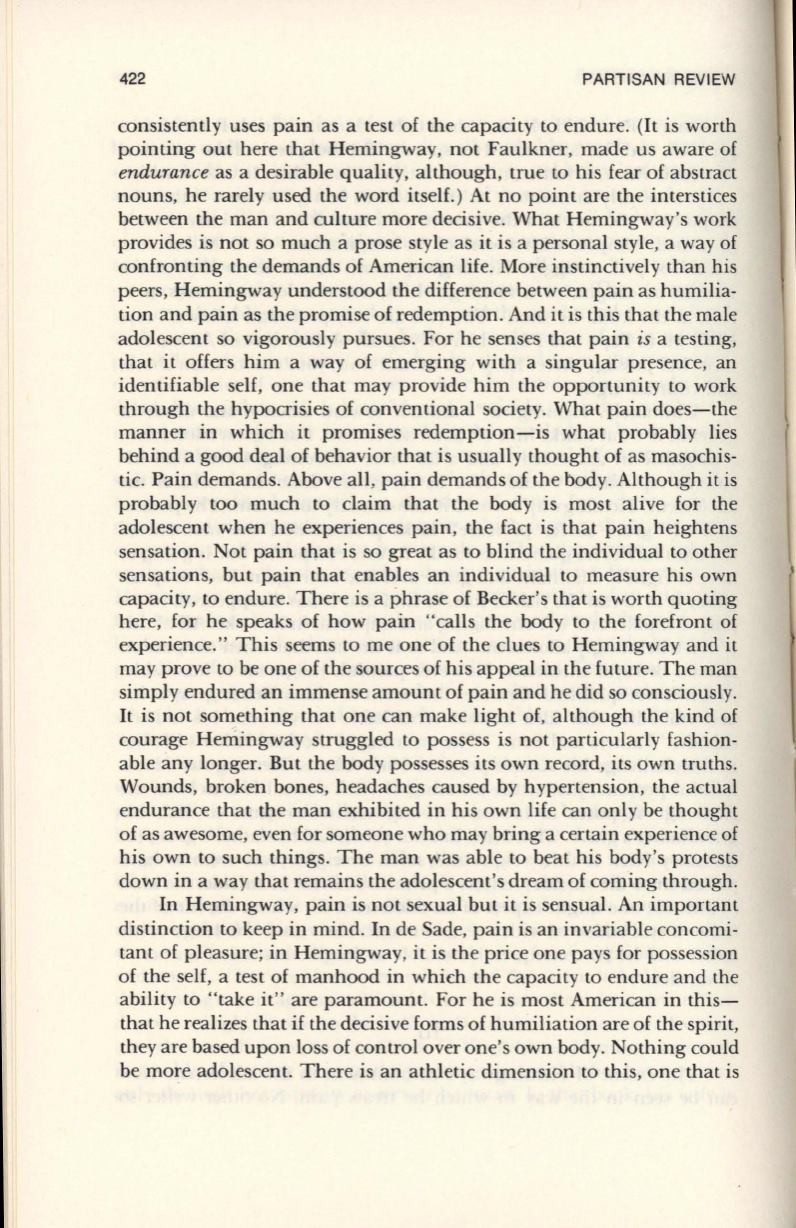
422
PARTISAN REVIEW
consistently uses pain as a test of the capacity to endure.
(It
is worth
pointing out here that Hemingway, not Faulkner, made us aware of
endurance
as a desirable quality, although , true
to
his fear of abstract
nouns, he rarely used the word itself.) At no point are the interstices
between the man and culture more decisive. What Hemingway's work
provides is not so much a prose style as it is a personal style, a way of
confronting the demands of American life. More instinctively than his
peers, Hemingway understood the difference between pain as humilia–
tion and pain as the promise of redemption . And it is this that the male
adolescent so vigorously pursues. For he senses that pain is a testing,
that it offers him a way of emerging with a singular presence, an
identifiable self, one that may provide him the opportunity to work
through the hypocrisies of conventional society. What pain does-the
manner in which it promises redemption-is what probably lies
behind a good deal of behavior that is usually thought of as masochis–
tic. Pain demands. Above all , pain demands of the body. Although it is
probably too much to claim that the body is most alive for the
adolescent when he experiences pain, the fact is that pain heightens
sensation. Not pain that is so great as to blind the individual to other
sensations, but pain that enables an individual to measure his own
capacity, to endure. There is a phrase of Becker's that is worth quoting
here, for he speaks of how pain "calls the body to the forefront of
experience." This seems to me one of the clues to Hemingway and it
may prove to be one of the sources of his appeal in the future. The man
simply endured an immense amount of pain and he did so consciously.
It is not something that one can make light of, although the kind of
courage Hemingway struggled to possess is not particularly fashion–
able any longer. But the body possesses its own record, its own truths.
Wounds, broken bones, headaches caused by hypertension, the actual
endurance that the man exhibited in his own life can only be thought
of as awesome, even for someone who may bring a certain experience of
his own to such things. The man was able to beat his body's protests
down in a way that remains the adolescent's dream of coming through.
In Hemingway, pain is not sexual but it is sensual. An important
distinction to keep in mind. In de Sade, pain is an invariable concomi–
tant of pleasure; in Hemingway, it is the price one pays for possession
of the self, a test of manhood in which the capacity to endure and the
ability to "take it" are paramount. For he is most American in this–
that he realizes that if the decisive forms of humiliation are of the spirit,
they are based upon loss of control over one's own body. Nothing could
be more adolescent. There is an athletic dimension to this, one that is


